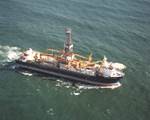North Sea Emerges
While the drilling slowdown in the U.S. lasted into the 1970s, other regions prospered. In the early 1960s activity opened up in the North Sea sparked by the growing consumer gas market in Europe. The Groningen gas field, discovered in 1959 offshore The Netherlands, had a major impact. Europe was much better e
While the drilling slowdown in the U.S. lasted into the 1970s, other regions prospered. In the early 1960s activity opened up in the North Sea sparked by the growing consumer gas market in Europe. The Groningen gas field, discovered in 1959 offshore The Netherlands, had a major impact. Europe was much better equipped than the U.S. to handle gas production from an offshore field, with onshore gas lines already installed when the find was brought to market. Also, this prospect was relatively close to shore which allowed reasonably inexpensive transportation.
Groningen led operators to believe that there would be other prolific fields in the area and exploration spread. Because the water was reasonably shallow the newly developed jackup rigs and semisubmersibles could be brought into play, as could jackets. By the mid-1960s, over 35 wells had been drilled in the southern U.K. sector of the North Sea and three major fields had been discovered. By 1967, first production was shipped to shore by British Petroleum.
As gas finds in the North Sea multiplied, operators also continued the search for oil. This took them into the central North Sea where waves, generated by storms on the Northern Atlantic, reached heights of 90 ft/28m. Such storms damaged drilling equipment and often left crews stranded on rigs for days. These conditions led to advances in semisubmersible technology. These vessels were built larger and heavier to handle beefed up mooring systems. Accommodation modules such as floatels were developed to allow crew members to remain safely offshore for longer periods.
In 1969, Phillips Petroleum made a discovery in the Norwegian sector of the North Sea that would eventually be known as Ekofisk. BP discovered the Forties field soon after, and by 1971 operators were demanding access to offshore exploration licenses from the U.K. and Norway. While the governments tried to pace production from the region the prolific nature of the finds meant virtually every lease produced a discovery. It was during this period that North Sea estimated reserves first surpassed those of the Gulf of Mexico.
With the new territory came new designs. While early structures installed in the southern North Sea copied the steel jackets of the Gulf of Mexico, the Central North Sea required something more. Norwegian fabrication yards developed concrete platforms, heavy enough that they did not require pilings for installation and held in place by gravity. Concrete platforms could be integrated inshore and floated out in Norway’s fjords as a complete unit, as opposed to the expensive prospect of installing a jacket offshore then lifting the topsides onto it. The first installation to go this route was Phillip’s Ekofisk followed by the Condeep gravity-based platform installed on Shell’s Brent field in 1975. In that same year four more platforms of this design were ordered.














